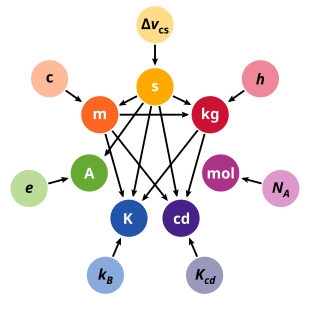Base size
Those physical quantities that are defined as the basis of a size system are called base quantities . According to the definition of the VIM , each base quantity is set in such a way that it cannot be expressed by other base quantities. In a comment on this, the VIM stipulates that numbers (“number of entities”) can be viewed as a base size in every size system. The choice of the basic parameters can be based on physical-practical or didactic aspects.
A system of sizes is always coupled with a corresponding system of units . The number of basic sizes determines the degree of the size system and the dimensionality of the unit system. For example, the International Size System (ISQ) is a seventh-degree size system and the associated International System of Units (SI) is a seven-dimensional system of units .
The qualitative properties of a basic quantity are expressed by its dimension . The dimension of a basic quantity is implemented as a basic unit (also: basic unit ) in the associated system of units .
International system of units
The International System of Units (SI) was initially based on 5 basic quantities (meter, kilogram, second, ampere, Kelvin) and was expanded to 7 basic quantities by adding the basic quantities mol and candela. These were defined separately, although others had to be known when defining some units (e.g. the definition of the ampere was based on the effect of force; the meter was redefined in 1983 using the speed of light and was from then on dependent on the second).
Since the redefinition of the system of units adopted on November 6, 2018 and which came into force on May 20, 2019, all units are determined by assigning a fixed value to seven fundamental constants . Nevertheless, the term “base unit” is still used.
| length | l , s | meter | m |
| Dimensions | m | kilogram | kg |
| time | t | second | s |
| Electric current | I. | amp | A. |
| Absolute temperature | T | Kelvin | K |
| Amount of substance | n | Mole | mol |
| Light intensity | I v | Candela | CD |
Examples
Example 1:
- In the international system of units, the basic unit of length is the meter and in the CGS system of units, centimeters . Both the basic units of meters and centimeters each represent the dimension length in their corresponding system of sizes.
In general, a dimension is always realized by a corresponding coherent unit . A base unit always represents a base quantity. In addition, it can also serve as a coherent unit for derived quantities of the same dimension.
Example 2:
- In the International System of Units, the meter is the base unit for the base quantity length . It also serves as a (coherent) derived unit for the amount of precipitation , expressed as volume per area.
The above example shows two quantities that are generally considered to be different types of quantities, but have the same coherent unit and dimension.
Derived quantity
According to the VIM, a derived quantity in a size system is a quantity that is defined as a function of the base quantities, and a derived unit is the unit of measurement for a derived quantity. It arises as the power product of the base units, while a base unit cannot be expressed as the power product of other base units. Other meanings of the term derived unit are irrelevant for the differentiation from the base unit.
Individual evidence
- ^ Joint Committee for Guides in Metrology : VIM (International Vocabulary of Metrology - Basic and General Concepts and Associated Terms ).
- ↑ “Prior to the definitions adopted in 2018, the SI was defined through seven base units from which the derived units were constructed as products of powers of the base units. Defining the SI by fixing the numerical values of seven defining constants has the effect that this distinction is, in principle, not needed [...] Nevertheless, the concept of base and derived units is maintained because it is useful and historically well established [ ...] ” , SI brochure, Chapter 2.3 [1]

